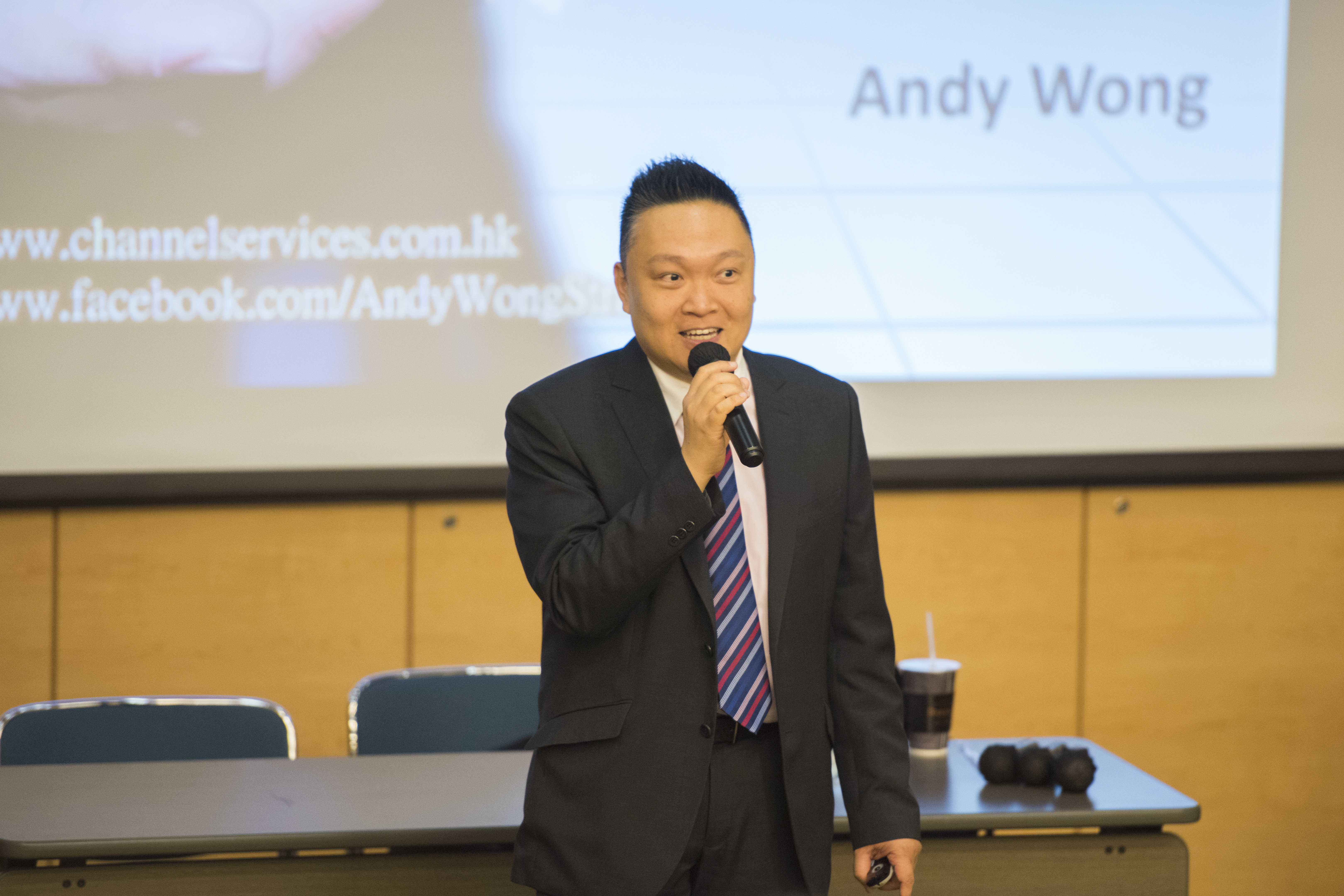教師實用溝通技巧
高效的溝通技巧對於教學和師生互動是很重要的。提升溝通能力並不是一時三刻的過程,也沒有一個完美、人人適用的方法。因此,教學中心在今年三月份邀請了身兼司儀和培訓師的黃文漢先生(Andy)進行了一個名為「教師實用溝通技巧」的研討會,與大家分享和示範溝通技巧。讓我們來重溫研討會中的一些亮點吧。
 講者黃文漢先生分享實用溝通技巧的心得。
(相片由教學中心提供,2017)
講者黃文漢先生分享實用溝通技巧的心得。
(相片由教學中心提供,2017)
非語言溝通
溝通並不局限於言語,非語言溝通包括眼神接觸、手勢、姿態和聲調也同樣重要。 從教師的身體語言,學生可感受到他們是否自信、有熱誠和風趣。 在研討會上,Andy開首就介紹了身體姿勢在公開演講中的重要性。怎樣才能令人看起來更自信?Andy 與參加者分享了一些小秘訣:
- 站立時,身體保持挺直,肩膀放鬆往後收
- 與觀眾保持眼神接觸
- 自然地呼吸
- 用微笑結束每一句說話
- 張開手臂,以表示開放和歡迎的態度
「黃金30秒」
「一場演講的成敗往往取決於頭30秒,就是所謂『黃金30秒』」。Andy說道。「在這短短的時間,學生對你和你該課節已定下印象。因此,你必須一開始就給學生一個深刻的開場白。」適當的提問有助於激發學生的思考,你也可以向學生講述自己的親身經歷或他人的故事,只要是真人真事就能打動學生。
演講結構
清晰合邏輯的演講結構有助學生了解你的講話。Andy以漢堡包為比喻,闡述了一個理想的演講結構。漢堡包頂是演講的主題介紹,漢堡包底是總結,而中間的餡就是演講內容的數個副題。
 以教授面試技巧為例,說明漢堡包式的演講結構。
(插圖由教學中心提供,2017)
以教授面試技巧為例,說明漢堡包式的演講結構。
(插圖由教學中心提供,2017)
言簡意賅
要有效地溝通,我們應該以清晰簡潔的語言來吸引觀眾。由於學生的專注力有限,漫長冗悶的演講會超出其專注力範圍。要令一個演說達到言簡意賅的效果,一個簡單的方法就是選擇精確的詞彙來表達我們的意思。 此外,Andy也建議用簡短、簡單的句子去表達複雜的意思。
建立關係
無論是父母與子女、師生,還是朋友之間,有效的溝通都是雙向的。Andy強調,只要雙方關係良好,溝通就自然有效。假如你能尊重學生及其想法,學生便會更加樂意與你溝通。教師不妨以學生的名字稱呼他們,與他們對話時保持眼神接觸及積極地聆聽他們來表示對他們的尊重。 廿一世紀的教室不再以教師為中心,教師應該尊重學生、肯定他們的努力及成就。
想了解更多溝通技巧?多留意教學中心的消息吧!
 在歡樂輕鬆的氣氛下,參加者 Angela 和 Eva
與大家分享他們與學生的溝通技巧。
(相片由教學中心提供,2017)
在歡樂輕鬆的氣氛下,參加者 Angela 和 Eva
與大家分享他們與學生的溝通技巧。
(相片由教學中心提供,2017)
How Can Teachers be Effective Communicators?
Effective communication skills are important for teachers’ facilitation and interaction with students. Enhancing one’s communication skills is not an overnight process, nor is there a perfect, one-size-fits-all solution. Therefore, Centre for Learning and Teaching (CLT) invited Mr Andy Wong, an experienced master of ceremonies and trainer, to share and demonstrate practical communication skills to our teachers in the seminar of “Practical Communication Skills for Teachers” in March this year. Followings are some highlights of the seminar.
 The speaker, Mr Andy Wong shares the tips of practical communication skills with our participants.
(Photo courtesy of CLT, 2017)
The speaker, Mr Andy Wong shares the tips of practical communication skills with our participants.
(Photo courtesy of CLT, 2017)
Non-verbal Communication
Communication does not only take place by means of words. Non-verbal communication, including eye contact, gestures, postures and tone of voice, is equally important. From the body language and other non-verbal signals of their teachers, students would perceive whether they are confident, enthusiastic and interesting. Andy began the seminar by introducing the importance of body postures in public speaking. How could we appear confident? Andy shared a few tips with our participants:
- Stand tall and keep shoulders down and back
- Keep eye contact with the audience
- Breath naturally
- Finish a sentence with a smiling face
- Open arms to convey an open and welcoming attitude
The Golden 30 Seconds
“The first 30 seconds of a presentation is crucial and we call it the golden 30 seconds,” explained Andy. “This is the time your students form the impression of you and your presentation. Therefore, you have to give your students a bang in the very beginning.” What should teachers do? Some rhetorical questions would be useful to stimulate students’ mind as they ponder to the answers. You could also tell a story, whether it is your own or borrowed from others, an authentic one would impress your students.
Structuring Your Presentation
A presentation needs a clear and logical structure that helps your students focus and understand. Andy drew an analogy between an ideal presentation structure and that of a hamburger, using the theme of “interview skills” as an example. The top of the bun is the introduction of the main theme while the bottom is the conclusion. The fillings between them are the sub-themes of the presentation.
 Presentation structure in form of a hamburger with
the example of teaching interview skills
(Image courtesy of CLT, 2017)
Presentation structure in form of a hamburger with
the example of teaching interview skills
(Image courtesy of CLT, 2017)
Being Concise
To be an effective communicator, you should engage your students through lucid and concise language. Since students’ attention span is limited, long and rambling speeches will extend beyond their attention span. To make a presentation concise, a simple way is to choose words that accurately depict what you want to say. Short and simple structured sentences are also preferred for delivering complex ideas.
Rapport Building
Effective communication is two-way, no matter it is between parents and children, between teachers and students, or between friends. Andy stressed that effective communication occurs when the two parties are in a positive relationship. Students would be more open to communicating with you if you convey respect for them and their ideas. These could be done by addressing your students by their names, making eye contact and actively listening to them when they speak. A 21st century classroom is no longer teacher-centred, teachers should respect their students as individuals and recognise their achievements.
Want to learn more about communication skills? Stay tuned with CLT!
 Our participants, Angela and Eva, share their experience in communicating
with students in a fun and relaxing atmosphere.
(Photo courtesy of CLT, 2017)
Our participants, Angela and Eva, share their experience in communicating
with students in a fun and relaxing atmosphere.
(Photo courtesy of CLT, 2017)
 講者黃文漢先生分享實用溝通技巧的心得。
(相片由教學中心提供,2017)
講者黃文漢先生分享實用溝通技巧的心得。
(相片由教學中心提供,2017) 以教授面試技巧為例,說明漢堡包式的演講結構。
(插圖由教學中心提供,2017)
以教授面試技巧為例,說明漢堡包式的演講結構。
(插圖由教學中心提供,2017) 在歡樂輕鬆的氣氛下,參加者 Angela 和 Eva
與大家分享他們與學生的溝通技巧。
(相片由教學中心提供,2017)
在歡樂輕鬆的氣氛下,參加者 Angela 和 Eva
與大家分享他們與學生的溝通技巧。
(相片由教學中心提供,2017)
 The speaker, Mr Andy Wong shares the tips of practical communication skills with our participants.
(Photo courtesy of CLT, 2017)
The speaker, Mr Andy Wong shares the tips of practical communication skills with our participants.
(Photo courtesy of CLT, 2017) Presentation structure in form of a hamburger with
the example of teaching interview skills
(Image courtesy of CLT, 2017)
Presentation structure in form of a hamburger with
the example of teaching interview skills
(Image courtesy of CLT, 2017) Our participants, Angela and Eva, share their experience in communicating
with students in a fun and relaxing atmosphere.
(Photo courtesy of CLT, 2017)
Our participants, Angela and Eva, share their experience in communicating
with students in a fun and relaxing atmosphere.
(Photo courtesy of CLT, 2017)